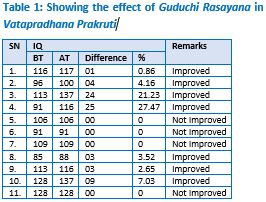Prospective study of Medhya effect of Guduchi Rasayana in different Dehaprakruti
DOI:
https://doi.org/10.21760/jaims.8.1.4Keywords:
Medhya, Guduchi Rsayana, Dehaprakruti, Intelligent QuotientAbstract
Ayurveda has explained the concept of Rasayana (Rejuvenating Therapy), a classical medication mainly aiming at protection of the individual's health and secondarily at pacification of disease. Different types of Rasayanas are described in Samhitas for specific purposes. Improvement of Medha i.e., intelligence is one of the benefits of consumption of Rasayana. Medhya Rasayana is one of the types of Rasayana which majorly deals with enhancement of Medha i.e., intelligence along with other benefits of Rasayana. The Medhya effect of Guduchi Rasayana is studied with the help of Intelligent Quotient i.e., IQ. The proper assessment of IQ is done with the help of Catell & Catell Intelligence scale. The normal functioning of Medha mainly depends on Pitta Dosha. Pitta in its normal state is Katu Rasatmak (Pungent taste) and related with the Satva Guna of Manas. Guduchi, being Katu-Tikta Rasatmak and Madhura Vipaka Dravya, purifies the Pitta Dosha and enhances Satva Guna by removing Tamas. Tikta Rasa has been described as Medhya by Vagbhatacharya. This study attempted to analyze any changes in IQ due to consumption of Guduchi Rasayana in different Dehaprakruti.
Downloads
References
Sushruta Samhita Sutrastha 1/19 with Dalhana-Teeka edited by Vd. Yadavji Trikamji Acharya and Narayan Ram Acharya Kavyateertha published by Chaukhamba Surbharati Prakashan, Varanasi- (2008) Pg. No. 5.
Sushruta Samhita Sharir Sthan 4/63 Dalhana-Teeka edited by Vd. Yadavji Trikamji Acharya and Narayan Ram Acharya Kavyateertha published by Chaukhamba Surbharati Prakashan, Varanasi- (2008) Pg. No. 360.
Ashtanga Samgraha (Sutrasthana) 1/15 with Shashilekha Commentary by Indu edited by Dr.Shivprasad Sharma published by Chaukhambha Sanskrit Series Office, Varanasi year- (2012) Pg No 5.
Agnivesha, Charaka, Dridhabala. In: Charaka Samhita, Chikitsa Sthana, Rasayana Adhyaya, 1/1/7-8. 5th ed. Vaidya Jadavaji Trikamji Aacharya., editor. Varanasi: Chaukhamba Sanskrit Sansthan, 2009; Pg No 376.
Agnivesha, Charaka, Dridhabala. In: Charaka Samhita, Sutra Sthana, Rasayana Adhyaya, 1/3/30-31. 5th ed. Vaidya Jadavaji Trikamji Aacharya., editor. Varanasi: Chaukhamba Sanskrit Sansthan, 2009; Pg No 385.
Culture Fair Intelligence Test Cattell, R. B. (1940). Culture Fair Intelligence Test (CFIT) [Database record]. APA PsycTests. https://doi.org/10.1037 /t14354-000
Sharangadhara Samhita Madhyam Khand Adhyay 1/2, Brahamanand Tripathi Chaukhamba Surbharati Reprint (2007) Pg No 125.
Developing guidelines for clinical research methodology in Ayurveda,” by the institute for postgraduate teaching & research in Ayurveda, Gujarat Ayurved university Jamnagar; comprising of 23 questions.















